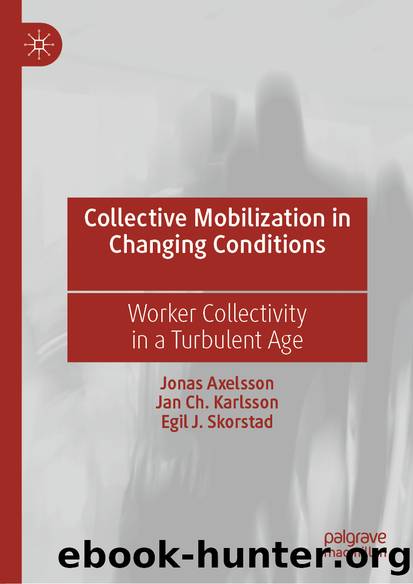Collective Mobilization in Changing Conditions by Jonas Axelsson & Jan Ch. Karlsson & Egil J. Skorstad

Author:Jonas Axelsson & Jan Ch. Karlsson & Egil J. Skorstad
Language: eng
Format: epub
ISBN: 9783030191900
Publisher: Springer International Publishing
Another worker commented on the use of computers and the Internet. Computers for personal use were not allowed at the mill, but the worker frankly told us that in spite of the regulations, private PCs were used for personal enjoyment in the control rooms .
Lysgaard often mentions that the workers made a sharp distinction between âusâ, that is the subordinate workers, and âthemâ, being the superordinates or management . This distinction was still in use in our interviews , but we find two exceptions. One is when they talked about the risk of downsizing or of the closedown of the workplace. Then âusâ meant the whole Peterson company without a contrasting âthemâ. The other exception was when they talked about the technical engineers that they worked with. The âusâ took on a meaning of us who understand the technical processes as opposed to those managers who only think about economic aspects and profit . The expression âus and them â had become more complex since Lysgaardâs time.
However, strong hostile attitudes towards management âat least until 2006 when the plant changed ownershipâwere not universally prevailing. In the interviews , we found examples of views on the period before the change of ownership that, apparently, are in direct contrast to Lysgaardâs findings. For instance, one of the workers claimed, âThere used to be an environment and a culture for working together [â¦] Management and employees worked together in order to improve production and of course also profitsâ. âMutual respectâ was also mentioned by the operators . At least until 2006, there seems to have been some degree of mutual respect between supervisors and subordinates , which appears strange in comparison with Lysgaardâs findings. Later, this developed to a positive view of the technical engineers and a strongly negative regard for other managers, which we return to in Chapter 6.
On the surface therefore, conditions of similarity and the process of identification in the years before the closure of Peterson appear to have been quite different from what they were in Lysgaardâs days. However, on closer examination, it is still possible to see some important similarities manifesting themselves in different ways. Furthermore, the similarities proliferated considerably in the wake of the takeover by the cowboys . They introduced a new regime that in several ways was a return to the 1950s, illustrated by the growing tendency towards direct control as well as the suspension of the participatory practices that had become a common procedure in matters related to organisational change. Interview statements show that the new style of leadership was considered to be unacceptable. The displacement of the traditional and trustworthy regime seems to have revitalised the workersâ identity and paved the way for collective resistance . During the last six years [â¦] we spoke of the newcomers [the new owners] as the cowboys . It was a totally different type of management . But they were rather shocked, because they thought that they could do exactly as they had done in other companies. But it was not like that here.
Download
This site does not store any files on its server. We only index and link to content provided by other sites. Please contact the content providers to delete copyright contents if any and email us, we'll remove relevant links or contents immediately.
| Anthropology | Archaeology |
| Philosophy | Politics & Government |
| Social Sciences | Sociology |
| Women's Studies |
Cecilia; Or, Memoirs of an Heiress — Volume 1 by Fanny Burney(31333)
Cecilia; Or, Memoirs of an Heiress — Volume 3 by Fanny Burney(30934)
Cecilia; Or, Memoirs of an Heiress — Volume 2 by Fanny Burney(30889)
The Great Music City by Andrea Baker(21323)
We're Going to Need More Wine by Gabrielle Union(18074)
Bombshells: Glamour Girls of a Lifetime by Sullivan Steve(13109)
Pimp by Iceberg Slim(12933)
All the Missing Girls by Megan Miranda(12753)
Fifty Shades Freed by E L James(12451)
Norse Mythology by Gaiman Neil(11885)
Talking to Strangers by Malcolm Gladwell(11880)
Crazy Rich Asians by Kevin Kwan(8351)
Mindhunter: Inside the FBI's Elite Serial Crime Unit by John E. Douglas & Mark Olshaker(7835)
The Lost Art of Listening by Michael P. Nichols(6474)
Enlightenment Now: The Case for Reason, Science, Humanism, and Progress by Steven Pinker(6407)
Bad Blood by John Carreyrou(5770)
The Four Agreements by Don Miguel Ruiz(5511)
Weapons of Math Destruction by Cathy O'Neil(5038)
We Need to Talk by Celeste Headlee(4871)
